| Home |
HAND
und INSTRUMENT |
Reviews |
Christoph Wagner |
Lectures/seminars | Consultation/contact |
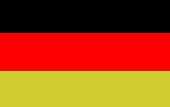 |
|
| "Hand Profile" |
        |
|||
|
An individual "Hand Profile"
is the result of a highly detailed examination by means of specialized
apparatuses, which comprise 20-40 characteristics of the hand
(Biomechanical Hand Measurement). (Chapter E). The individual’s data is
being compared with the musician’s reference group (see musicians' data). By doing so, an objective
and detailed picture of the manual advantages and limitations in
relation to the specific instrument can be obtained.
In Chapter G, Musicians' Hands - Musicians' Fates, numerous Hand Profiles of professional musicians and music students illustrate the great diversity of manual disposition. Among the case studies, participants of competitions can be found, but also musicians with serious manual disadvantages. Hand Profiles help to understand many difficulties in playing technique and physical ailments experienced in connection with the instrument; they also point out individual solutions. (HAND UND INSTRUMENT, pp. 191-253). |
|||
|
On the left side of the Hand Profile
the selected hand characteristics are listed. The raster on the right
contains the nine so-called decile values of the reference group. It is
this decile raster (see below), that allows comparison between the
individual musician’s data and his/her reference group.
Interpreting the Hand Profile:
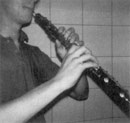 With the switch from the oboe to the cor
anglais, pain occurred in the right arm, which can be understood when
studying the Hand Profile: The wrist’s limitation of movement in
direction of the thumb (see line 18) and extremely short thumb and
little finger (lines 4 and 5) make the handling of the larger
instrument more difficult. Since these With the switch from the oboe to the cor
anglais, pain occurred in the right arm, which can be understood when
studying the Hand Profile: The wrist’s limitation of movement in
direction of the thumb (see line 18) and extremely short thumb and
little finger (lines 4 and 5) make the handling of the larger
instrument more difficult. Since these 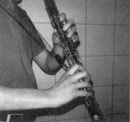 handcharacteristics are practically
unchangeable, the only chance – after a longer interruption of playing
- was to either consciously control the optimization of the positioning
of hand and arm at the instrument, or to adapt the instrument to the
player’s hand by means of ergonomic improvements (HAND UND INSTRUMENT,
p. 220). handcharacteristics are practically
unchangeable, the only chance – after a longer interruption of playing
- was to either consciously control the optimization of the positioning
of hand and arm at the instrument, or to adapt the instrument to the
player’s hand by means of ergonomic improvements (HAND UND INSTRUMENT,
p. 220).
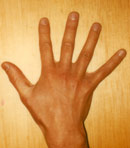 The
pianist was facing the question,
whether
he would have to give up his profession as a musician due to very
serious limitations in his technique. The main reason was an extremely
reduced span width of the thumb (see line 21), leading to a significant
reduction of all spans where the thumb was involved (lines 6-9).
Further disadvantages added to this problem (lines 10, 13, 17). It was
not possible to compensate these disadvantages by other advantageous
hand characteristics. Two surgeries aiming to improve the mechanics of
the thumbs’ tendons had failed. Almost more dramatic than the manual
problems themselves appeared to be the psychological strain, which had
developed in the course of these years. The pianist had noticed the
difficulties with the instrument already at age 15 . By generating a
Hand Profile at the right time, this development could have been
foreseen and steered in a different manner (HAND UND INSTRUMENT, p.
202ff.) The
pianist was facing the question,
whether
he would have to give up his profession as a musician due to very
serious limitations in his technique. The main reason was an extremely
reduced span width of the thumb (see line 21), leading to a significant
reduction of all spans where the thumb was involved (lines 6-9).
Further disadvantages added to this problem (lines 10, 13, 17). It was
not possible to compensate these disadvantages by other advantageous
hand characteristics. Two surgeries aiming to improve the mechanics of
the thumbs’ tendons had failed. Almost more dramatic than the manual
problems themselves appeared to be the psychological strain, which had
developed in the course of these years. The pianist had noticed the
difficulties with the instrument already at age 15 . By generating a
Hand Profile at the right time, this development could have been
foreseen and steered in a different manner (HAND UND INSTRUMENT, p.
202ff.)How a Hand Profile is generated… The Decile Raster – in fact a table identical to those found in the musicians’ data – is generated in the following way: The reference group’s measurements are ranked, values ascending. These rows are divided by the 9 “Decile Values” into 10 sections , each section thus containing 10% of all the measurements. On the extreme left (below D1) lie the 10% of the smallest values, on the extreme right the 10% (above D9) of the largest. How far the values below D1, respectively beyond D9 extend, cannot be retrieved from this illustration. – The numerical values are omitted in the raster in favour of better legibility.
Now, the individual’s values can be inserted into this “ranking”, structured by 10%-steps. Either a value (coincidentally) corresponds with a decile value or it lies above (cell on the right) or below (cell on the left). By converting the values into deciles it is of no importance whether a hand characteristic has been measured in millimetres or angle degrees. The dot always reflects the individual’s position compared to his “colleagues”. (Also the connecting lines only serve the purpose of better legibility.) |
EXAMPLE 1 – Music Student Oboe/Cor Anglais (21 years, H 492) 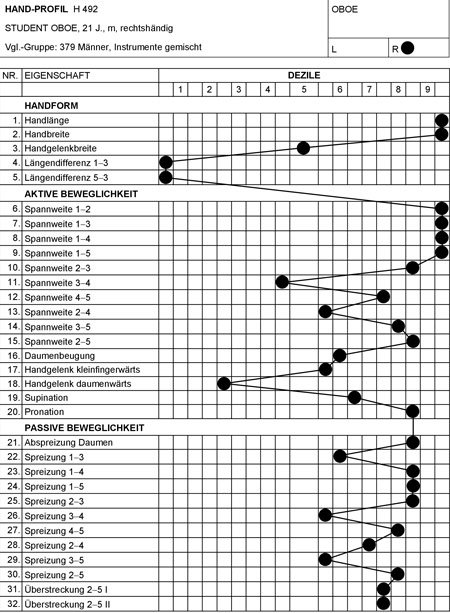 EXAMPLE 2 – Pianist (33 years, H 519) 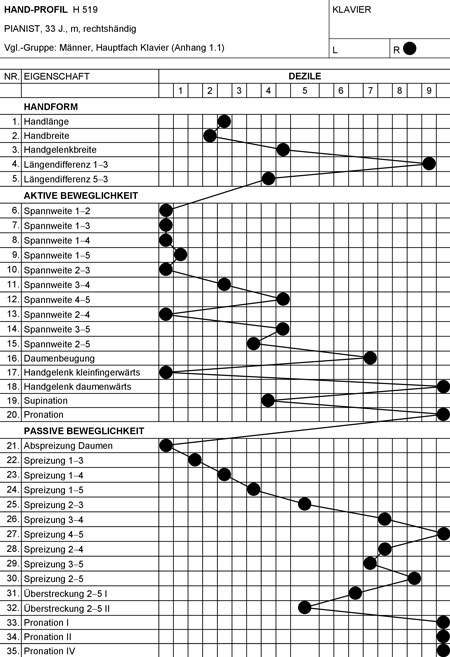 |
||
|
|
to the top | Copyright 2006/07 Christoph Wagner |